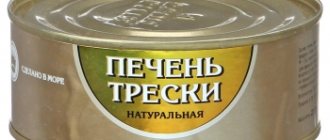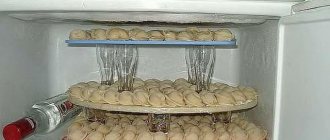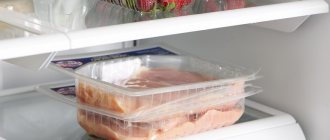- Shelf life: 2 days
- Shelf life: 2 days
- Shelf life in the refrigerator: 2 days
- Freezer life: 200 days
Storage conditions:
Store at a temperature not exceeding +6 °C
Liver is a useful product. It contains a lot of useful substances, such as zinc, iron, phosphorus, copper, as well as many vitamins of groups A, B, C and E.
The beneficial properties of liver are excellent when consumed, especially when signs of fatigue, weakened vision and general loss of strength appear. It helps restore strength after illness and helps improve health. A large number of different nutritious dishes can be prepared from this product. Before cooking, it is recommended to soak the liver in milk. It is better to defrost it in the refrigerator, and under no circumstances should you use a microwave oven for defrosting. Care must be taken when choosing a product. Because if the liver is damaged, it may contain dangerous toxins.
Shelf life of poultry liver
Let's figure out how long you can store chicken liver or other poultry, depending on its temperature condition.
- if the product temperature is from 0 to +2˚C, it is recommended to store it for no longer than 2 days;
- if the temperature is from -1˚C to +1˚C - no longer than 4 days;
- It is recommended to store the product in polymer packaging in a gas environment with a temperature from 0˚C to +4˚C for no longer than 15 days.
It is recommended to store frozen poultry by-products at temperatures from -2˚C to -3˚C for no longer than 7 days from the date of production.
- at a temperature of minus 8 ° C they are stored for no longer than 2 months;
- deep frozen at a temperature not exceeding minus 18 °C - no more than 6 months.
Shelf life of food in the freezer
| Name | storage conditions | shelf life limits | months/days |
| By-products of slaughtered animals (liver, kidneys, tongue, heart, brains) | -18 °C | 6 | months |
| Fatty fish | -18 °C | 3 | months |
| Low-fat fish | -18 °C | 6 | months |
| Seafood (shrimp, mussels, squid, etc.) | -18 °C | 4 | months |
| Semi-finished pizza (with sausage, ham, mushrooms, beef, assorted) | -18 °C | 3 | months |
| Semi-finished large-piece boneless meat products from pork and beef, including salted form | -18 °C | 3 | months |
| Semi-finished portioned and small-piece boneless meat products from pork and beef, including with sauces (beef stroganoff, shish kebab, etc.) | -18 °C | 30 | days |
| Semi-finished small-piece meat and bone products from pork and beef (stew, dressing for soups, set for broth, etc.) | -10 °C | 25 | days |
| Semi-finished minced shaped and minced meat (cutlets, steaks, kebab, meatballs, etc.) | -10 °C | 30 | days |
| Semi-finished meat products from lamb, large pieces | -18 °C | 30 | days |
| Semi-finished portioned and small-piece lamb products | -18 °C | 30 | days |
| Semi-finished meat and bone products from lamb | -18 °C | 25 | days |
| Semi-finished minced lamb products | -18 °C | 30 | days |
| Semi-finished frozen dumplings, pasties, manti, cabbage rolls | -18 °C | 3 | months |
| Semi-finished poultry meat pieces | -18 °C | 9 | months |
| Semi-finished poultry meat products, whole carcasses | -18 °C | 12 | months |
| Ready-made dishes, including broths and soups, sauces, cutlets, etc. | -18 °C | 3 | months |
| Vegetables and fruits, except melons, cucumbers, cabbage, lettuce, celery and radishes. | -18 °C | 12 | months |
| Tomatoes | -18 °C | 2 | months |
| Sweet pepper | -18 °C | 4 | months |
| Zucchini and pumpkin | -18 °C | 10 | months |
| Apples | -18 °C | 4 | months |
| Apricots | -18 °C | 6 | months |
| Peaches | -18 °C | 4 | months |
| Unprocessed mushrooms | -18 °C | 4 | months |
| Boiled mushrooms | -18 °C | 12 | months |
| Berries | -18 °C | 6 | months |
| Nuts | -18 °C | 24 | months |
| Greens and herbs | -18 °C | 12 | months |
| Ice cream | -18 °C | 2 | months |
| Yeast-free dough | -18 °C | 6 | months |
| Yeast dough (subject to shock freezing) | -18 °C | 3 | months |
| Shortbread or puff pastry | -18 °C | 5 | months |
| Margarine and butter | -18 °C | 9 | months |
| Bakery products (bread, muffins, etc.) | -18 °C | 3 | months |
| Cakes and pastries (subject to blast freezing) | -18 °C | 18 | months |
The HACCP system (HACCP - Hazard Analysis and Critical Control Point), introduced mandatory for food industry enterprises from February 1, 2015, is based on 7 basic principles of HACCP, which are the foundation for the development of a system for monitoring the quality and safety of products.
Today, EMAS are the most advanced and effective standard in the world. ISO 14000 is just a part of it, although an integral and essential one. Both standards are voluntary. Why are they needed and what is the difference?
The HACCP (HACCP) system, the basis of which is risk analysis and work with CCP, as a food safety management system, is a guarantor of the quality of food products and increases the competitiveness of the enterprise. The introduction of HACCP at a food enterprise is one of the ways to reduce the threat to the health of food consumers.
Large retail chains: Magnit, Perekrestok, Lenta, Auchan, Pyaterochka, Karusel and others, conduct an audit before concluding an agreement with a food supplier. Only after a positive answer to all questions is given, the supplier is considered to have passed the audit, and the retail chain enters into an agreement with him.
The HACCP (HACCP) system, the basis of which is risk analysis and work with CCP, as a food safety management system, is a guarantor of the quality of food products and increases the competitiveness of the enterprise. The introduction of HACCP at a food enterprise is one of the ways to reduce the threat to the health of food consumers.
How to cook delicious liver
There are several simple tricks that will help give the dish an appetizing taste. Let's talk about some of them:
- If you plan to use frozen liver for cooking, you do not need to wait until it is completely defrosted. Frozen liver is easier to cut into the necessary parts;
- To make the film easier to remove, lubricate the liver with lemon juice or rub with salt. You can also keep it in the freezer for a few minutes;
- If you want to get rid of the bitter taste of the liver, soak it in milk for 3-4 hours. This will give it a soft and delicate taste;
- After soaking the liver in milk, lightly rub it with soda, leave for 1-2 hours, and then wash thoroughly under running water;
- To make a hard liver softer, you can beat it a little with a hammer;
- To fry breaded liver, you can use ground crackers or flour;
- To get a delicious stewed liver, it is best to first boil it and then simmer it;
- Whatever dish you prepare from liver, try to add salt towards the end of the dish’s cooking.
How long does liver last?
When buying liver, you need to take into account some points so that the product can last as long as possible (if there is a need for it). When choosing, you should pay attention to the color of the liver; it should not be too light - too light a shade of the product indicates that it is stale. If the blood contained in the liver is too dark, brown in color, such a liver should not be taken. Smell - there should not be a “sour” smell, or simply an unpleasant odor. You should carefully examine the liver lining - if you see whitish inclusions, these are probably liver parasites. Having purchased a good-quality product, you need to preserve it.
Based on GOST 32244 “Processed meat by-products. Technical specifications”, the shelf life of the liver is as follows:
| Thermal state of offal, packaging method | Storage Modes | Recommended shelf life, including transportation, no more than | |
| Air temperature, °C | Relative humidity, %, not less | ||
| Chilled offal packaged without vacuum | From 0 to plus 4 | 85-90 | 1 day (including at the manufacturing plant no more than 8 hours) |
| From minus 1 to 0 | 85-90 | 2 days (including at the manufacturer no more than 16 hours) | |
| Chilled offal, vacuum packed | From minus 1 to plus 1 | 85-90 | 3 days |
| Frozen offal | Not higher than minus 12 | 95-98 | 4 months |
| Not higher than minus 18 | 6 months | ||
| Not higher than minus 20 | 7 months | ||
| Not higher than minus 25 | 10 months | ||
Shelf life of liver in the refrigerator
The permissible shelf life of fresh liver in the refrigerator is no more than two days at a temperature not exceeding +6 degrees Celsius.
Based on SanPiN 2.3.2.1324-03 “Hygienic requirements for shelf life and storage conditions of food products,” the shelf life of liver at a temperature of +2 to +6°C is 24 hours.
If you do not plan to use fresh liver within 1-2 days , it is better to store it in the freezer to extend its shelf life.
Shelf life of liver in the freezer
Frozen liver can be stored in a freezer at a temperature of -8-10 degrees for 2-3 months from the date of production.
At temperatures from -18 degrees and below, the shelf life of the liver can reach 6 months .
At temperatures of -25 degrees and below, liver can be stored for up to 10 months .
Keep in mind that liver is a delicate and delicate product, so it should not be frozen more than once. Repeated freezing of the liver leads to its damage, which can harm you in the future.
How long to store food: everyday observations
It is worth considering that mono-component products deteriorate more slowly (for example, boiled rice, beans, pasta without dressing). Boiled root vegetables with their skins can be stored in the refrigerator for up to a week if not peeled. Among multi-component dishes, those that use vinegar or contain other organic acids can withstand storage for 2-4 days - for example, cooked fish or raw vegetables in marinade, soups with sauerkraut. The most favorable storage place for prepared dishes in the refrigerator is the top shelf or the zero “freshness zone” in advanced models.
The data on expiration dates published below, determined by SanPiN 42-123-4117-86, can be taken into account rather as food for thought. That is, focus on the ratios of indicators that indicate the most perishable products, and not take a specific number of hours as a norm.
Storing liver without refrigeration
Liver is a perishable product. In this regard, storing it unrefrigerated (at room temperature) is strongly not recommended. Only in extreme cases, when it is not possible to place the product in the refrigerator, can you leave it at room temperature for a period not exceeding 10-12 hours.
In this case, it is advisable to take some measures to reduce the temperature of the product. For example, place it in a tight bag and in cold water with ice.
Storing the liver outside the refrigerator for long periods of 10-12 hours should not be allowed.
Interesting to know
Freezing food is one of the simplest forms of food storage. But how long can you keep food in the freezer before it goes bad?
Let's look at the freezer storage time in more detail, giving clear instructions, taking into account that the food is well wrapped in bags or containers.
Some vegetables, especially green leafy vegetables, must be blanched before they can be frozen. Blanching is processed with hot water to prevent browning. Frozen vegetables generally have a shelf life of 1 year. The exceptions are: Sweet pepper, chili pepper - 3-4 months, corn - 8 months, tomato - 3-4 months, zucchini and pumpkin - 8 months.
Basically, fruits are stored for 1 year. Only apples - 4 months, apricots - 6 months, bananas - 8 months, peaches - 4 months, berries - 6 months (strawberries - 1 year). Fruit juices are also stored for 1 year.
Nuts can be placed in the freezer for up to 2 years.
Do you use expired food for cooking at home?
Yes, the main thing is to process it if it is meat or expired kefir for pancakes.
27.72%
No, it is very dangerous and not useful.
36.37%
If the products have fungus or mold, then we throw them away; if they are a couple of days past their expiration date, we use them for food, even without heat or other treatment.
35.91%
Voted: 1952
Bacon - 3 months, Chops - 6 months, organ meats (liver, kidneys, etc.) - 4 months, roasts - 1 year, sausages - 3 months, steaks - 8 months.
Poultry carcasses (chicken, turkey, duck) are stored for 1 year. Raw poultry meat can be stored for 9 months. Cooked parts - 4 months. Poultry offal is stored for 4 months.
Fatty fish (tuna, mackerel, salmon) can be stored in the freezer for 3 months. The rest of the fish is stored for 6 months. Crayfish - 4 months, raw crab - 3 months, raw shrimp - 4 months, raw squid and octopus - 4 months.
Butter can be stored in the freezer for 9 months, ice cream for 2 months. In theory, other dairy products can be frozen, but the ones that retain their shape and are mostly used are butter and ice cream.
Bakery products
Bread - 3 months, muffins - 2 months, pancakes and waffles - 1 month, flatbreads - 3 months.
Nuts can be placed in the freezer for up to 2 years.










